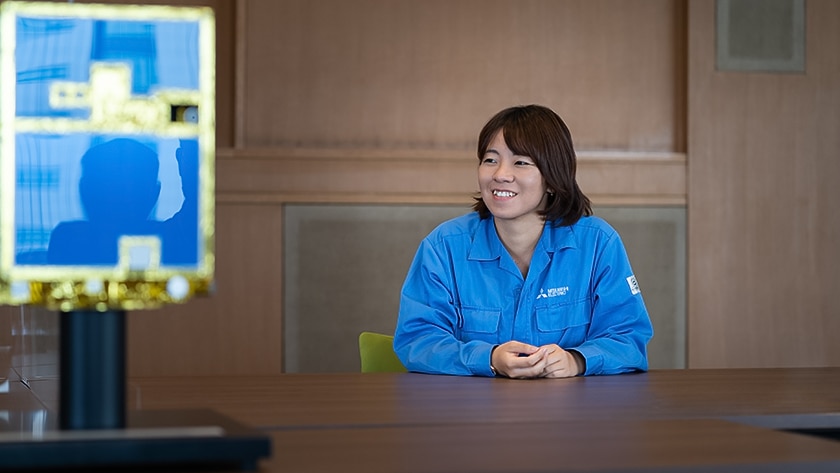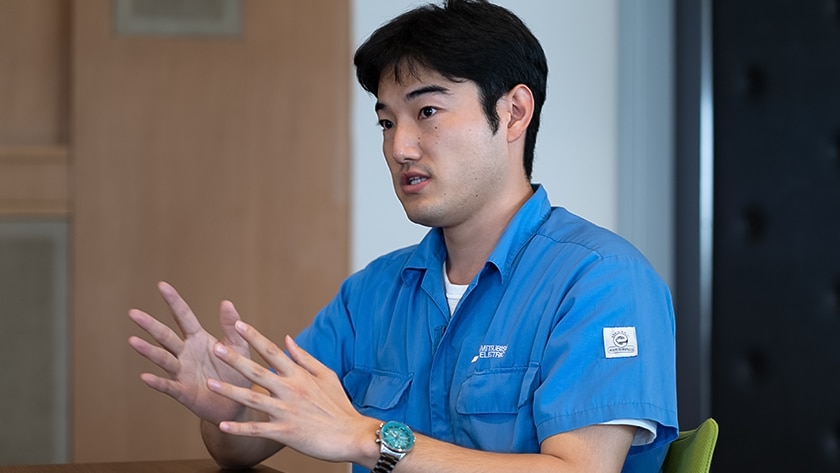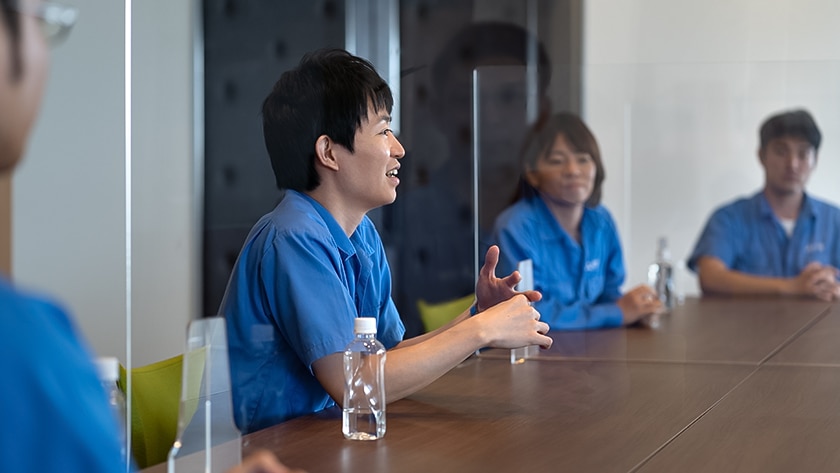Looking to the Stars: Mitsubishi Electric Ups Its Satellite Game
29th October, 2020

Mitsubishi Electric’s medium and large satellites — developed with the company’s advanced technologies and many years of experience in the field — have helped countries around the world participate in space exploration. But with tech startups and other private companies entering the field, the company needed to find a way to stay one step ahead of its leaner, very agile competition. Led by an eager group of young engineers, Mitsubishi Electric found its answer in an increasingly high-demand market it had so far not tapped into: small satellites.

A Fresh Approach
It all started with a series of brainstorming sessions organized by young engineers.
"We were talking about the possibility of developing commercial small satellites that form constellations," says Shuhei Kamiya of the company’s Advanced Satellite Systems Department. "One topic that always comes up in this field is lowering costs, so we discussed ways to build a satellite for as little cost as possible. We also discussed global trends in satellite development and other aspects. That’s where it all began."
Constellations, in this case, refers to networks of dozens of small satellites working together to provide the kind of global coverage needed by large-scale data businesses and internet providers. Many are currently being developed in public sector projects taking place in countries around the world. Mitsubishi Electric is no stranger to satellite development; however, its specialty has long been in medium and large satellites, rather than the small satellites that compose constellations.
The young engineers continued exploring their idea, but they hit a snag: they lacked opportunities to demonstrate their technology. After all, they couldn’t just launch a new satellite into space whenever they wanted to. Their chance came when the Japanese government announced its Innovative Satellite Technology Demonstration Program, which invited private companies and universities to put into orbit and demonstrate devices, parts, microsatellites, and other satellite tech that they had developed. As part of the program, Mitsubishi Electric was commissioned to develop a small satellite of around 100 kg that will serve as a platform for the assorted parts and devices.

Reliability at Low Cost
Compared to major national projects involving large satellites weighing several tons, designing a small satellite may feel like scaling back. However, tackling this smaller project allowed Mitsubishi Electric to take on new challenges — such as tight schedules, miniscule budgets, and other harsh conditions — that required a different mindset to navigate than with the company’s larger projects.
"We were very limited in what we could do to realize the project," Kamiya says. "The budget issue in particular was a headache — we needed to ruthlessly cut as much as we could to even make the project happen. We had to throw away everything we knew about how past engineers designed Mitsubishi Electric’s medium and large satellites, and we had to try everything we could to achieve quality assurance and high performance at low cost."
Once launched, a satellite cannot be repaired if something happens. If it malfunctions, it simply becomes another piece of space debris, possibly endangering other space exploration projects. For this reason, safety and quality assurance are just as important in designing small satellites as they are for large satellites, says Sota Mizutani of the company’s Product Quality Department.
"Designing a satellite so that it doesn’t malfunction over the course of a long mission is a matter of reliability and safety," he says. "It cannot be compromised, regardless of what the budget may be. The satellite needs to launch safely, and its controls need to be reliable so that one false move doesn’t cause it to plummet into another country. Safety needs to be incorporated in the design right from the planning stages."
A Bigger Slice of the Market
Teams building a small satellite are usually given only half as much time, and less than a tenth of the budget allotted for a large satellite. As a result, the young Mitsubishi Electric engineers needed to approach the project less like a team working for a global conglomerate and more like a startup company — remaining agile and thinking on their feet. The challenging nature of this project pushed the young engineers to develop skills that may be beneficial in the long run.
"Large satellites are, to an extent, modeled on past projects," says Yuki Koshiro of the Comprehensive Space Systems Department, who is in charge of designing the overall system controlling orbital satellites. "But in a project like this, in which the budget is astronomically low but you’re still expected to produce solid results, we had to learn to reassess every little thing to determine what was necessary and what wasn’t. In that sense, I had a lot of say over the project, which I found to be a very valuable experience, but at the same time, that meant I had to deal with a lot more obstacles than in a typical project."
Yohei Tsujimoto, who develops and maintains satellite ground systems in the same department, mentions another valuable aspect of the project. "When working on large satellites, I never get to see the entire picture — how the system works as a whole," he says. "But working on this small satellite, I got to see the entire system for the first time. The best part about this project is that every day is a new learning experience where I get to try things I’ve never had the opportunity to do."
The team is currently in the final stage of the planning phase and will soon be moving on to the testing phase, still on track to complete the satellite in time for the fiscal year 2021 launch of the Epsilon rocket. Kamiya — who at only 33 is leading this project, the success of which could open up a new business avenue for Mitsubishi Electric — says that through this experience, his team of young engineers will help enhance the company’s presence in the global space industry.
"Internationally, our competitors still have a much larger presence," he says. "But I think there are still many opportunities for us to take a larger bite out of the market. I’ve attended many international conferences and events, and what I’ve learned from talking to the people there is that if we can offer the right balance of quality, performance, and cost, we can attract a significant number of clients. If we can apply the knowledge we gain from this project to lower costs and achieve even greater performance without sacrificing the quality and reliability found in our medium and large satellites, I think we can breathe new life into the Mitsubishi Electric business model."
(This article was originally published on September 24, 2020)
The content is true and accurate as of the time of publication.Information related to products and services included in this article may differ by country or region.



